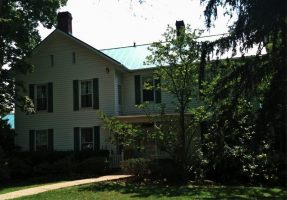My First Creative Writing Class
This past winter break, I was especially excited to return to Kenyon and transition back into a weekly class schedule because I had a creative writing class that I’ve been looking forward to taking. From what I’ve heard (and experienced) about creative writing at Kenyon, it’s an extremely competitive process. You have to submit an online application, in which you write about why you want to take one of the three classes you rank in order of preference. You must also provide a brief writing sample. Since more students apply for the courses than there are seats available, professors have to make some tough decisions when reviewing applications. I didn’t expect to make it into a class this semester, but when I received an email informing me that I had been accepted into Professor Katharine Weber’s special topic course “Creative Writing Workshop: Fiction, Non-Fiction, and Other Narrative Forms,” I was ecstatic!
I’m only a few weeks into the course, but already I’m slightly overwhelmed and increasingly thrilled by this unexplored side of Kenyon. I’ve traced my thought process from these past five weeks below to give you a sense of what I’m experiencing.
 1. Treleaven? Where the heck is that?
1. Treleaven? Where the heck is that?
Apparently, everything about this class was meant to be foreign to me — even its location. However, after looking at a campus map (and spending a few minutes wandering around the post office), I found the mysterious Treleaven House. In case you’re curious, it’s on Brooklyn Street, just past Campus Auto and Fuel and the Hillel House. It’s home to the Rural Life Center and a lovely seminar room with several large windows that reveal a pleasant view of the open area surrounding the building.
2. Procrastination will be the death of me.
My love-hate relationship with procrastination is becoming more and more apparent to me as a result of this class. On the one hand, the past three semesters have allowed me to greatly improve my ability to complete assignments at the last possible moment before they are due. On the other, I am beginning to realize that my tendency to procrastinate on the huge amount of work I am assigned for this once-a-week class is slowly killing me. To properly complete the readings, make thoughtful critiques on my classmates’ pieces and write my response to the next prompt, I have to learn to start working earlier rather than later in the week.
3. Reading critically is an active process.
I’ve learned how to read critically for other literature classes, but reading critically for a creative writing class has forced me to develop an entirely new perspective on the task. While I still analyze themes, meaning and style in the short stories and texts we read in class, I also have to focus more closely on narrative strategies and techniques. To figure out how to recreate the elements I see in the texts we read, I need to pick apart how the author puts his or her story together. Additionally, part of our reading assignments involves taking detailed notes of our observations and critical thoughts about the material as we read. This nearly doubles the amount of time I spend reading.
 4. Professor Weber gives great advice.
4. Professor Weber gives great advice.
Over the course of the class period, she frequently refers to authors we should look into and texts we should read to improve our creative writing skills. My class notes often feature little asides in which I list people or books to Google later. Furthermore, she throws out great one-liners and quotes when she sees an opportunity for a teachable moment. For instance, before dismissing the class and sending us off to read and critique the work of our peers for the first time, she made a point to tell us that when we are reading another person’s writing, we must be careful to distinguish between our own writing style and the author’s. Just because we might have expected the story to progress in a certain way or would have written it differently does not mean that it is a flaw in the writer’s work. When we read, Professor Weber advises us to “fall under whatever spell is being cast” (a quote from another writer she refers to frequently). Therefore, our critiques should be more meaningful, addressing specific ways the story could be enhanced beyond our personal tastes.
5. My classmates are my best critics.
When we discuss our pieces in class, I’m always amazed by the details my peers pick up on. Their thoughtful critiques have inspired me to look more closely at my classmates’ writing when I’m thinking of constructive comments for them. They also encourage me to pay more attention to what I write and the way I convey my ideas. During the in-class evaluation of the first piece I submitted, one of my classmates mentioned that she originally thought my story was set in a much earlier time period because the main character referred to her parents as “Mother” and “Father” instead of “Mom” and “Dad.” In reality, my story took place in modern times. I just hadn’t thought about how this word choice influenced the tone or implied a certain time frame in my story.
It’s easy to curl up in your protective shell and deflect the criticisms that come your way, but I try to actively listen to the comments of my peers because they often point out things in my writing that I didn’t even notice. While I may not agree with everything they say, as a whole, their comments are incredibly useful. I think that’s one of the benefits of taking a creative writing class at Kenyon. You have the chance to share your writing with a group of peers who help you improve, while simultaneously providing constructive criticism that will help them enhance their writing as well.
